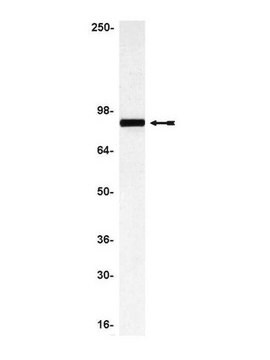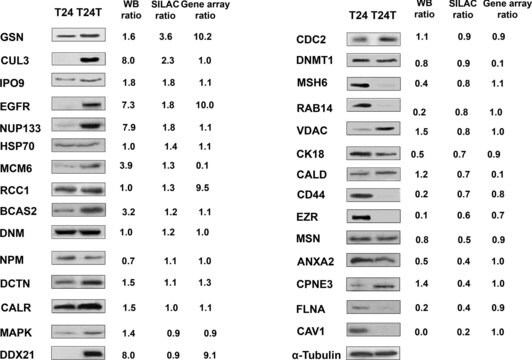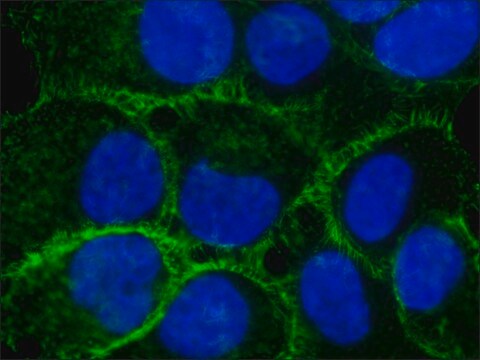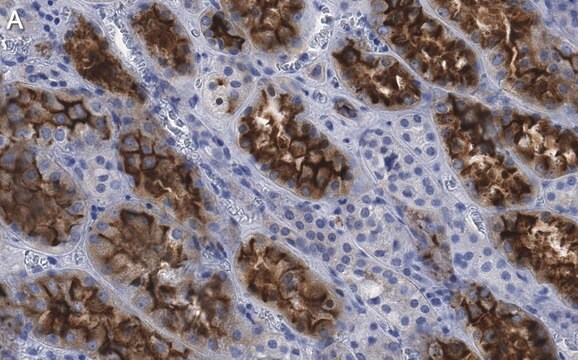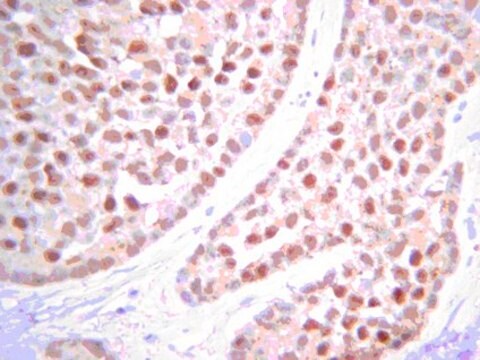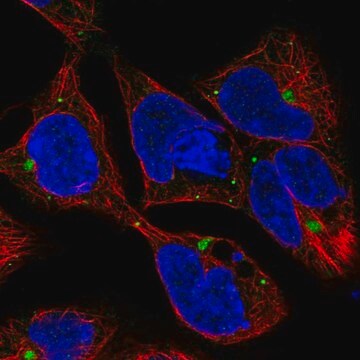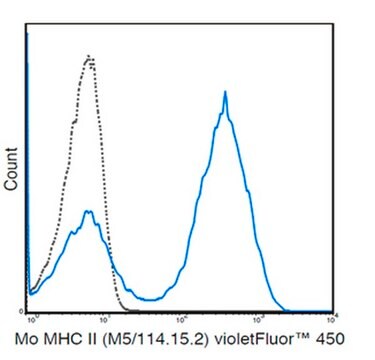MAB3822-C
Anti-Ezrin Antibody, clone 4A5, Ascites Free
clone 4A5, from mouse
Synonym(e):
Cytovillin, Villin-2, p81, Ezrin
About This Item
Empfohlene Produkte
Biologische Quelle
mouse
Qualitätsniveau
Antikörperform
purified immunoglobulin
Antikörper-Produkttyp
primary antibodies
Klon
4A5, monoclonal
Speziesreaktivität
human, rat, rabbit, mouse
Methode(n)
electron microscopy: suitable
immunocytochemistry: suitable
immunohistochemistry: suitable
immunoprecipitation (IP): suitable
western blot: suitable
Isotyp
IgG1κ
NCBI-Hinterlegungsnummer
UniProt-Hinterlegungsnummer
Versandbedingung
wet ice
Posttranslationale Modifikation Target
unmodified
Angaben zum Gen
human ... EZR(7430)
Allgemeine Beschreibung
Spezifität
Immunogen
Anwendung
Zellstruktur
Adhäsions-Proteine (CAMs – Zelladhäsionsmoleküle)
Immunohistochemistry Analysis: A representative lot detected a higher Ezin immunoreactivity in paraffin-embedded human medulloblastoma sections when compared with normal cerebellum sections (Haeberle, H., et al. (2012). Neoplasia. 14(7):666-669).
Immunohistochemistry Analysis: A representative lot immunostained parietal cells in rabbit gastric mucosa (Hanzel, D.K., et al. (1989). Am. J. Physiol. 256(6 Pt 1):G1082-G1089).
Immunoprecipitation Analysis: A representative lot immunoprecipitated Ezin from human A431 cells. The immunoprecipitated Ezrin was phosphorylated on Ser66 from dbcAMP‐treated, but not cAMP‐treated, A431 cells (Wang, S., et al. (2009). Cell Res. 19(12):1350-1362).
Electron Microscopy Analysis: A representative lot detected Ezrin on microvilli of the intracellular canaliculi (IC) and the subapical region of resting parietal cells in Lowicryl HM20-embedded rabbit gastric gland ultrathin sections (Sawaguchi, A., et al. (2004). J. Histochem. Cytochem. 52(1): 77–86).
Immunocytochemistry Analysis: A representative lot detected exogenously expressed human GST fusion protein by fluorescent immunocytochemistry staining of formaldehyde-fixed, Triton X-100-permeabilized rabbit gastric parietal cells (Zhou, R., et al. (2003). J. Biol. Chem. 278(37):35651-35659).
Western Blotting Analysis: A representative lot detected both the endogenous rabbit Ezrin as well as exogenously expressed human Ezrin GST fusion proteins in transfected rabbit gastric parietal cells (Zhou, R., et al. (2003). J. Biol. Chem. 278(37):35651-35659).
ELISA Analysis: Clone 4A5 hybridoma culture supernatant was screened for its immunoreactivity by ELISA and found to react with both dentured and non-denatured 80 kDa Ezrin preparations from rabbit gastric glands/mucosa vesicular fractions (Hanzel, D.K., et al. (1989). Am. J. Physiol. 256(6 Pt 1):G1082-G1089).
Qualität
Western Blotting Analysis: 0.5 µg/mL of this antibody detected Ezrin in 10 µg of L6 rat myoblast lysate.
Zielbeschreibung
Physikalische Form
Lagerung und Haltbarkeit
Sonstige Hinweise
Haftungsausschluss
Sie haben nicht das passende Produkt gefunden?
Probieren Sie unser Produkt-Auswahlhilfe. aus.
Lagerklassenschlüssel
12 - Non Combustible Liquids
WGK
WGK 1
Flammpunkt (°F)
Not applicable
Flammpunkt (°C)
Not applicable
Analysenzertifikate (COA)
Suchen Sie nach Analysenzertifikate (COA), indem Sie die Lot-/Chargennummer des Produkts eingeben. Lot- und Chargennummern sind auf dem Produktetikett hinter den Wörtern ‘Lot’ oder ‘Batch’ (Lot oder Charge) zu finden.
Besitzen Sie dieses Produkt bereits?
In der Dokumentenbibliothek finden Sie die Dokumentation zu den Produkten, die Sie kürzlich erworben haben.
Unser Team von Wissenschaftlern verfügt über Erfahrung in allen Forschungsbereichen einschließlich Life Science, Materialwissenschaften, chemischer Synthese, Chromatographie, Analytik und vielen mehr..
Setzen Sie sich mit dem technischen Dienst in Verbindung.